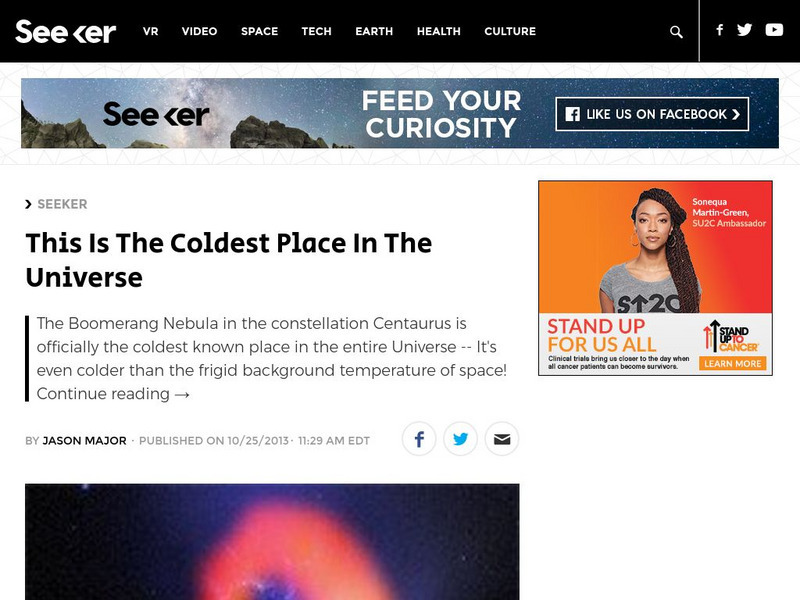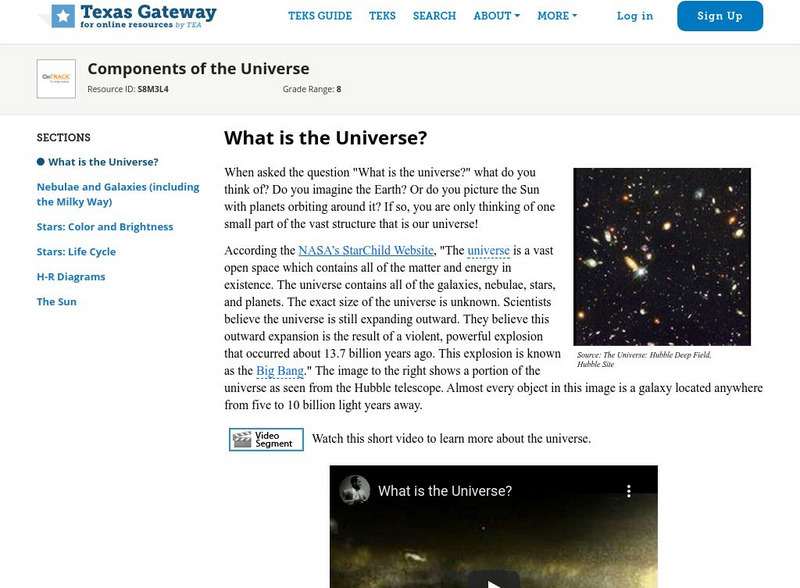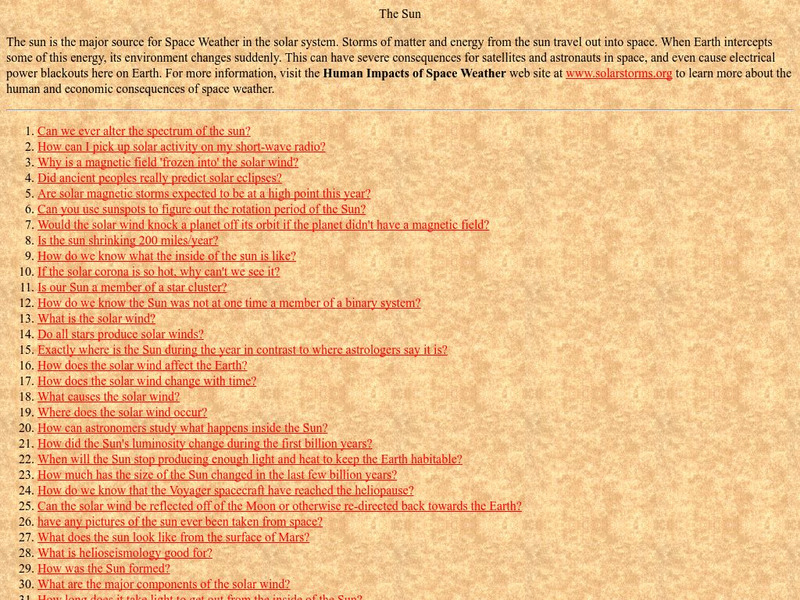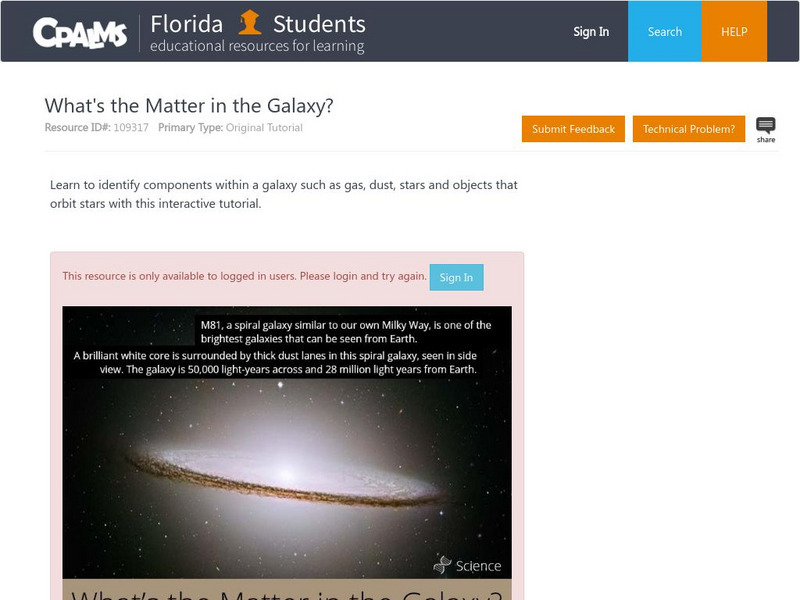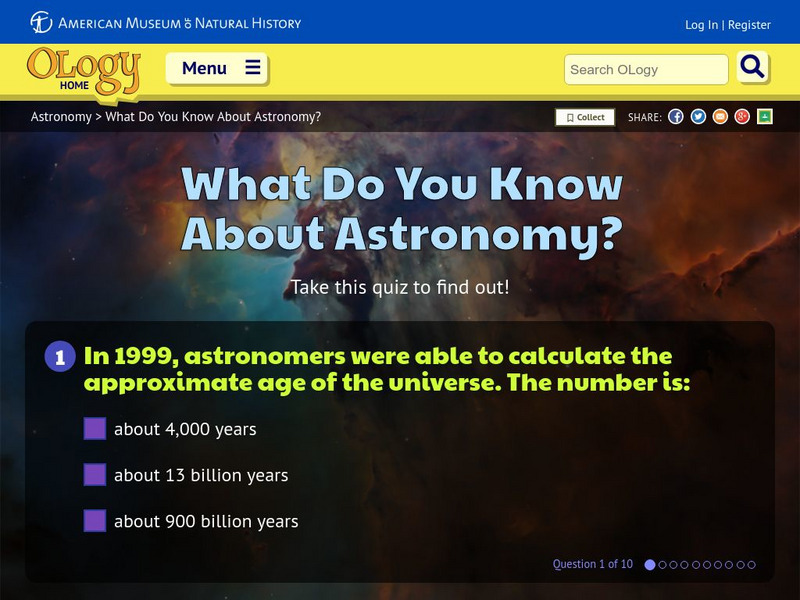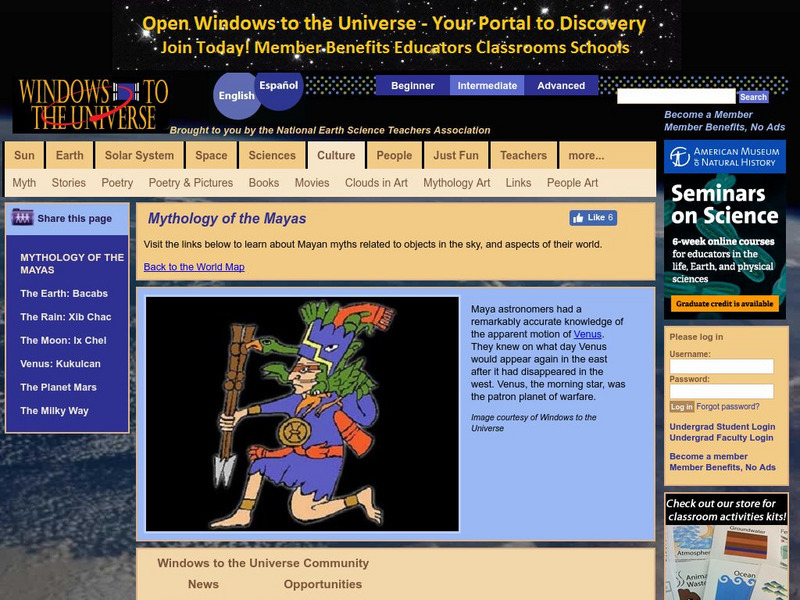Mocomi & Anibrain Digital Technologies
Mocomi: What Is a Galaxy?
Explains what galaxies are and their different shapes. Includes details on the Milky Way.
Mocomi & Anibrain Digital Technologies
Mocomi: How Big Is the Universe?
Provides facts about the Universe, Jupiter, the Milky Way Galaxy, and Superclusters.
Other
An Atlas of the Universe
What does the universe look like? This website offers visitors a collection of images that serve as an "atlas" of our universe. See multiple charts showing the Earth's distance from the Sun and other stars, find helpful terms in a...
Science Buddies
Science Buddies: The Moon and the Stars
When you are in the city, only a few of the brightest stars are visible. But when you are in the country, you can see many more stars than you can count. Sometimes you can even see the bright belt of our galaxy, the Milky Way. In this...
Seeker
Seeker: Week of 10 28 13: This Is the Coldest Place in the Universe
Article reports on the discovery by scientists that the Boomerang Nebula in the Milky Way is the coldest known place in space.
Texas Education Agency
Texas Gateway: Introduction to Motion
What do you think of when you hear the word motion? Are you moving right now? You may not think so, but you are. Remember, the Earth is moving around the Sun, and the Sun is moving around the Milky Way Galaxy. Everything in the universe...
Globio
Glossopedia: Stars
Many of the objects you can see in the night sky are stars, large objects in space that produce light. Our galaxy, the Milky Way, contains more than 100 billion stars. Stars are so far away that their light does not reach us for years....
Other
University of Leicester: Spiral Galaxies
Provides a general overview of spiral galaxies, including descriptions of the different classes of spiral galaxy.
University of Wisconsin
University of Wisconsin: The Constellations and Their Stars
An excellent site dedicated to the constellations and information about the objects which make them up. Contains a great deal of information about various stars, galaxies and other objects, as well as details on how best to observe them.
Other
Powersource: Cherokee Stories
This site from Powersource gives links to many Cherokee myths, including the "Cycle of the Seasons" and "Rock House: Why the Sun Follows the Moon." These are both good examples of the Cherokee religious beliefs of creation.
NASA
Nasa: Jet Propulsion Laboratory: Planet Quest: Exoplanet Exploration
Constellation of articles, images, diagrams, posters, videos, and more on the subject of the search for planets, particularly Earth-like planets, outside our solar system.
Texas Education Agency
Texas Gateway: What Is the Universe?
The following tutorial is an explanation of what the universe is composed of.
NASA
Nasa: Image Science Center: Ask the Space Scientist
A NASA space scientist provides 98 questions and answers about the sun, the center of our solar system.
CPALMS
Florida State University Cpalms: Florida Students: What's the Matter in the Galaxy?
A tutorial that looks at the components within a galaxy such as gas, dust, stars and objects that orbit stars. A PDF file of the tutorial is available.
Enchanted Learning
Enchanted Learning: The Planets
This survey of the planets includes all the basics, size, mass, atmosphere, length of day, and the like. It features interactive activities and learning exercises and compares all of the planets in colorful tables.
PBS
Pbs Learning Media: Solar System Scale Model
Teach the concept of scale models and the size of the solar system through this extensive lesson plan. Students will learn about scale models, estimate which objects to use to create a scale model of Earth and Sun, and figure out how far...
BBC
Bbc: Uranus a Mission
Very good narrative about Voyager's mission past Uranus. Details the difficulties of the voyage, as well as containing very good pictures of its moons.
NASA
Nasa: Hubble Finds 16 Exoplanet Candidates
In the past, extrasolar planets have either been too far away to detect or conditions did not allow them to be seen. Hubble has made this possible and has determined that planets are as abundant in other areas of the milky way as they...
American Museum of Natural History
American Museum of Natural History: O Logy: What Do You Know? Astronomy
Take this ten-question self-scoring quiz to test your knowledge of astronomy facts: age of the universe, why stars and planets are spheres, where other life might exist in the outer space, the Milky Way, and more.
TED Talks
Ted: Ted Ed: Is There a Center of the Universe?
It's been a long road to the discovery that Earth is not the center of the Solar System, the Milky Way, or the universe; great thinkers from Aristotle to Bruno have grappled with it for millennia. But if we aren't at the center of the...
TED Talks
Ted: Ted Ed: Could Human Civilization Spread Across the Whole Galaxy?
Could human civilization eventually spread across the whole Milky Way galaxy? Could we move beyond our small, blue planet to establish colonies in the multitude of star systems out there? These questions are pretty daunting, but their...
Space Telescope Science Institute
Space Telescope Science Institute: Hubble Space Telescope
Find out how astronomers are conducting extensive observations to estimate how many planets in our Milky Way galaxy might be potential abodes for life.
National Earth Science Teachers Association
Windows to the Universe: Mythology of the Mayas
This article from the Windows to the Universe gives information on Mayan myths related to the Earth, rain, the Moon, Venus, Mars, and the Milky Way. There are illustrations and explanations of vocabulary. Choose from beginner to advanced...





